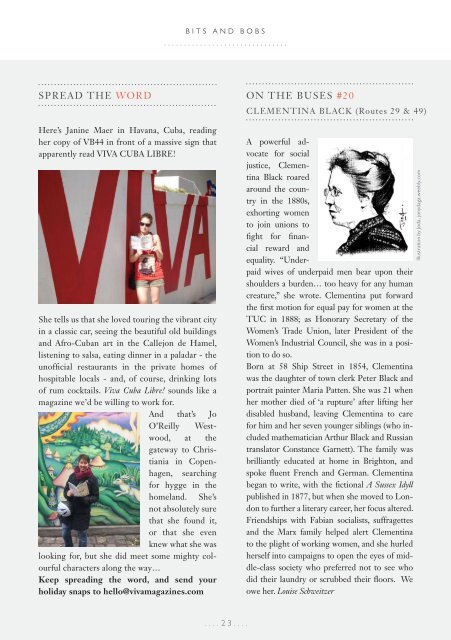Viva Brighton Issue #46 December 2016
Create successful ePaper yourself
Turn your PDF publications into a flip-book with our unique Google optimized e-Paper software.
BITS AND BOBS<br />
...............................<br />
SPREAD THE WORD<br />
Here’s Janine Maer in Havana, Cuba, reading<br />
her copy of VB44 in front of a massive sign that<br />
apparently read VIVA CUBA LIBRE!<br />
She tells us that she loved touring the vibrant city<br />
in a classic car, seeing the beautiful old buildings<br />
and Afro-Cuban art in the Callejon de Hamel,<br />
listening to salsa, eating dinner in a paladar - the<br />
unofficial restaurants in the private homes of<br />
hospitable locals - and, of course, drinking lots<br />
of rum cocktails. <strong>Viva</strong> Cuba Libre! sounds like a<br />
magazine we’d be willing to work for.<br />
And that’s Jo<br />
O’Reilly Westwood,<br />
at the<br />
gateway to Christiania<br />
in Copenhagen,<br />
searching<br />
for hygge in the<br />
homeland. She’s<br />
not absolutely sure<br />
that she found it,<br />
or that she even<br />
knew what she was<br />
looking for, but she did meet some mighty colourful<br />
characters along the way…<br />
Keep spreading the word, and send your<br />
holiday snaps to hello@vivamagazines.com<br />
ON THE BUSES #20<br />
CLEMENTINA BLACK (Routes 29 & 49)<br />
A powerful advocate<br />
for social<br />
justice, Clementina<br />
Black roared<br />
around the country<br />
in the 1880s,<br />
exhorting women<br />
to join unions to<br />
fight for financial<br />
reward and<br />
equality. “Underpaid<br />
wives of underpaid men bear upon their<br />
shoulders a burden… too heavy for any human<br />
creature,” she wrote. Clementina put forward<br />
the first motion for equal pay for women at the<br />
TUC in 1888; as Honorary Secretary of the<br />
Women’s Trade Union, later President of the<br />
Women’s Industrial Council, she was in a position<br />
to do so.<br />
Born at 58 Ship Street in 1854, Clementina<br />
was the daughter of town clerk Peter Black and<br />
portrait painter Maria Patten. She was 21 when<br />
her mother died of ‘a rupture’ after lifting her<br />
disabled husband, leaving Clementina to care<br />
for him and her seven younger siblings (who included<br />
mathematician Arthur Black and Russian<br />
translator Constance Garnett). The family was<br />
brilliantly educated at home in <strong>Brighton</strong>, and<br />
spoke fluent French and German. Clementina<br />
began to write, with the fictional A Sussex Idyll<br />
published in 1877, but when she moved to London<br />
to further a literary career, her focus altered.<br />
Friendships with Fabian socialists, suffragettes<br />
and the Marx family helped alert Clementina<br />
to the plight of working women, and she hurled<br />
herself into campaigns to open the eyes of middle-class<br />
society who preferred not to see who<br />
did their laundry or scrubbed their floors. We<br />
owe her. Louise Schweitzer<br />
Illustration by Joda, jonydaga.weebly.com<br />
....23....


















